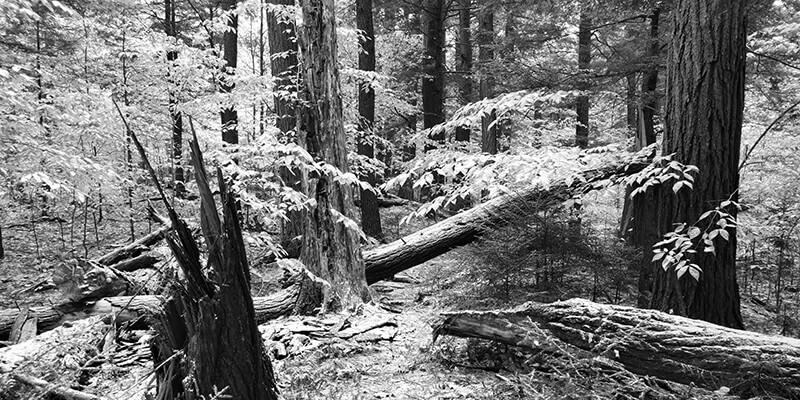Humans have shaped the landscapes of North America, for millennia, through fire, agriculture, hunting, and other means. The arrival of Europeans on America’s eastern shores several centuries ago ushered in the rapid conversion of forests to other land uses. By the twentieth century, old-growth forests in the eastern United States appeared to be gone, replaced by cities, farms, transportation networks, and second-growth forests.
Since that time, forest scientists have discovered, mapped, and studied numerous remnants of eastern old growth. Many of these ancient, sometimes mystical, stands remain surprisingly complex and vigorous.
“There is often a highly romanticized notion of old growth; people like to imagine these forests as pristine and never changing,” said William Keeton, forest ecologist at the University of Vermont (UVM). “But contemporary old-growth ecology paints a different picture, one no less mysterious and intriguing, yet challenging because it requires a fundamental shift in thinking and an acceptance that change itself is part of healthy, well-functioning forest ecosystems.”
Ecologists are eager to develop strategies for old-growth restoration and for nurturing additional stands of old growth that will foster biological diversity, reduce impacts of climate change, and serve as benchmarks for how natural systems operate. In recent decades, forest researchers have intensively tested many of these silvicultural strategies, which are now ready for more general use.
“We have to recalibrate,” added Keeton, a professor in the UVM Rubenstein School of Environment and Natural Resources and fellow in the Gund Institute for Environment. “The retrained eye sees the messy consequence of natural disturbances, for example, as complexity—as niches for biodiversity and as evidence of the old-growth system operating as it should.”
Keeton and ecologist Andrew Barton at the University of Maine, have compiled Ecology and Recovery of Eastern Old Growth Forests (Island Press, November 2018), a book that breaks new ground in understanding ecological systems and their importance for forest resilience in an age of rapid environmental change.
“The relatively small amounts of remaining old-growth forest in eastern North America are threatened as never before by continued clearing, global change, and invasive pests and pathogens,” said Keeton. “To conserve what is left, adaptive old-growth conservation and forest management approaches are more important than ever.”
The edited volume looks at a wide diversity of ecosystems, including spruce-fir, northern deciduous, mid-western hardwood and pine systems, southern Appalachian deciduous, southern swamp hardwoods, and longleaf pine. The book spans a broad geographic canvas, from eastern Canada and the Upper Great Lakes states to the deep South.
Chapters authored by more than 40 leading old-growth experts explore the processes that sustain these old-growth ecosystems and the services they provide. Experts examine the latest topics of contemporary forest ecology including forest structure and dynamics, below-ground soil processes, biological diversity, differences between historical and modern forests, carbon and climate change mitigation, old-growth effects on stream systems, disturbance dynamics, management for old-growth characteristics, and more.
Authors communicate these important new discoveries to scientists, land managers, and students and breathe fresh life into the hope for sensible effective management of old-growth stands in eastern forests.
“While the eastern old-growth of the future may not look just like the old-growth of the past, we can hope to sustain the biodiversity and the critical functions these ecosystems provide,” said Keeton, who wrote in the final chapter, “With care and attention, future generations will be able to have the experience of walking into an eastern old-growth forest, and perhaps they too will catch a glimpse of something timeless, mysterious, and compelling.”
